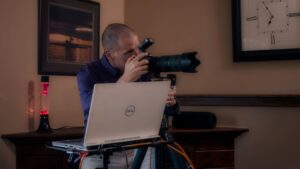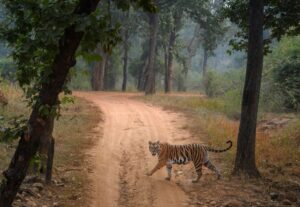
As you begin doing any kind of art, you start to discover what you like by what you’re gravitating to and when you think you’ve done a good shot. You learn a lot about yourself by doing art.
Patty Maher
You can also listen to this episode on iTunes, Pocket Casts, Spotify, Castbox, and Google Podcasts.

This week’s episode is all about award-winning fine art photographer Patty Maher. Patty specialises in mysterious portraiture, a genre that allows her to explore thought-provoking themes such as loneliness, grief, and space. Many of her portraits feature anonymous models in surreal landscapes.
We talk about:
– The concept of negative space and why it inspires Patty
– Tips on writing a compelling and meaningful artist statement
– The beauty of finding inspiration in everyday situations
& much more!
Patty’s optimism and creativity are contagious! She shares a lot of interesting and helpful
Here is a preview of our conversation with Patty Maher.

Q: How are you able to express a wide variety of emotions without showing your models’ faces?
Patty Maher: When I first started, I did show faces. Then, somehow, I really gravitated to not. I wasn’t 100% aware of it. Yahoo used to do this thing through Flickr where they’d choose a photographer, fly them in to New York, and do a feature about their
When they were trying to figure out what angle to take with the story, that’s what they commented on. They said, “You never show faces.” It was, to be honest, a surprise! I wasn’t intentional at that point. I was like, “I guess I don’t.”
After that, I started to really consider why I don’t show faces. One of the reasons is because some of my photos are self portraits. I didn’t want them to be pictures of me at all. I always thought, “Who would buy a picture of me and put it on the wall?” I wouldn’t even do that. Why would I expect someone else to do it? Also, I think it makes the photo more mysterious. It causes there to be more of a story. Regardless of who I’m shooting, I just tend not to show faces.
If you start to take pictures of models and not showing faces, it’s amazing how the smallest change in gesture, posture, or positioning within the frame can completely change the story. Whenever I shoot, because it’s digital, I shoot hundreds of photos in a session. And then I just look through them looking for that. That exact posture that says the thing I wanted to say. It’s really amazing how those subtleties are what can convey a message or a story.

Q: What’s the most interesting photo interpretation someone has shared with you?
Patty Maher: When I did that Yahoo interview with Flickr, that particular video went viral. I got so many emails; crazy amounts, like hundreds into my inbox. What was amazing to me was people were kind and so generous with their compliments. There were so many interpretations of specific photos. That was the first time I really got insight into how people write their own stories with my work and any work, and that was really interesting.
One of the photos that got a lot of commentary was one where I’m sitting in a field on a chair. There’s another chair in front of me. That was really interesting because so many people identified with that photo, which again, I had no idea that that would happen when I made it.
This woman wrote to me. The photo made her think of her and her husband – her husband had recently died – and that was so moving to me. It was very causative for her in a good way, to see that photo. Somehow, it confirmed something in her. There were a lot of different interpretations of that.
I can’t think of the most interesting, but I think it’s always interesting for me to hear what people think and what they see in my photos. For that reason, I try not to overexplain what I mean in the photo because I don’t want to cloud their experience with it by putting too much of my own emotions on it. I just put it out there.
I have a whole series I did when my mother was dying. There’s obviously a lot of grief. If you look at that series, you can see the grief in it. When I put it out there, I don’t didactically explain what each photo means because it’s very personal to me. I want people to have their own personal experience with it. If you allow too much of your own emotion to be said about it, it can eclipse someone else’s feelings.

Q: You prioritise having fun during your photoshoots, which is very important, and, in my opinion, quite difficult to do. What should photographers do to have more fun during their shoots?
Patty Maher: I’ve definitely had those concerns and those feelings. Last fall, I got to a point where I wasn’t having fun. Everything felt like I was trying to do these photos and I was doing them two or three times, which I don’t normally do. I just couldn’t seem to get it right. And then I thought, “You know what? Put down the camera.” I literally put it down and I haven’t yet picked it up, which is fine.
I think that’s one thing that’s really important to recognise: you can take breaks from your art. Sometimes it’s really important and necessary. It should be fun and it should be enjoyable. If it’s not, you’re probably not going to get the results that you want.
The most important thing is not to consider the result while you’re making the photo. I’ve done shoots where I know right away, in camera, that nothing’s gonna fly here. I usually take it home and double check on my computer because every once in a while, I can be wrong. Mostly, I know by looking at the back of my camera if something’s working or not. It’s important to have your own experience with it.
I used to go through phases, especially when I was new, that I’d sometimes put out photos to see if they were good and let other people tell me if they were good. That’s terrible. That’s a terrible, terrible way to be because then, you’re on the hook of the random Internet to tell you your feelings.
Now, I only put out a photo if I have gotten something out of it myself. Because then, you win. If it doesn’t hit the Instagram algorithm just the right way and you don’t get as many likes as you’re used to; if you feel good – and you got something out of that process – then you win in the art game, if you will. I think the world is very finicky and fickle. Sometimes people love what you do, and sometimes they don’t. You as the creator need to love what you do, and it’s hard. You can’t always love every single thing you do, but you need to feel it. If you’re not feeling it, go back to the drawing board. I’m a big writer in notebooks. I’ve got notebooks filled with just random stuff that I write, trying to get to the heart of what I’m creating and why. If you get aligned with those things, the rest tends to fall into place.
Links
Join Our Photography Community!









